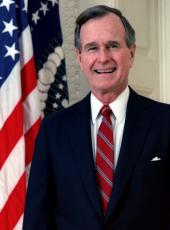Good to see you all. Please be seated. Let me just welcome everybody here. And special thanks to Henson Moore, our Deputy Secretary at Energy, who, along with Jim Watkins, who's not here today, has been such a driving force for our national energy strategy. Dr. Sunderman, we salute you, sir, the director of the Solar Energy Research Institute; Hank Habicht of the EPA Administration; Mike Deland and, of course, Dr. Bromley, our Science Advisor.
And may I pay my respects to the Members of Congress who are with us. Senator Johnston has taken a leadership role early on, on this Senate energy bill. Senator Hank Brown, very active in it. And Congressmen Hefley and Schaefer and Skaggs, all of you, a warm welcome to the White House.
Before we get started, let me congratulate the Senate Energy Committee on approving a comprehensive energy bill that incorporates many of the key elements of our strategy. I urge the full Senate to act on this bill swiftly. I also hope that the House Energy and Commerce Committee will complete action on energy legislation this fall. The country needs an enacted energy strategy.
For 7 months now, we've been highlighting the strengths of our national energy strategy, a comprehensive, we feel, balanced approach to accomplish the goals of continued economic growth, increased energy efficiency, strong environmental protection, and a reduced dependence on foreign oil.
One of the most important themes in our national energy strategy is the more efficient use of energy resources. We must keep America on the cutting edge of new technologies, like alternative fuels, electric cars, solar and geothermal energy, high-speed rail, and advanced, even safe nuclear energy facilities. We must encourage environmentally responsible development of all U.S. energy resources, including renewable energy.
Renewable energy does reduce demand upon our other finite natural resources. It enhances our energy security and, clearly, it protects the environment.
Cost-effective renewable energy technologies can contribute in their way to a strong and growing economy: Domestically, by spurring competition and innovation in U.S. markets, and in our balance of trade by displacing more expensive imported energy and providing new services and products for export.
We saw during the past year how important this is to our national security.
We don't have to wait for scientific breakthroughs to capitalize on renewable energy technologies. We just need to translate our success in the lab into progress in the marketplace. And we must continue focused, industry-driven R&D to realize the full potential of these technologies.
In the last 2 years, we have increased the Federal budget for renewable energy research and development by 78 percent and have started construction on a new Federal lab. This funding has supported R&D in a number of important areas: Photovoltaic cells that convert sunlight to electricity; advanced turbines that harness the power of the wind; and new ways of producing ethanol and methanol for our cars and trucks.
It's easy to criticize and complain that we're not doing enough in promoting renewable energy. We will leave that to others, while we quietly here do the hard work which will make renewable energy technologies a reality in the marketplace.
Much of this progress, I call it outstanding progress, has been accomplished in Golden, Colorado, at the Department of Energy's Solar Energy Research Institute, SERI. SERI has excelled in R&D and in technology transfer. This year SERI scientists have won four of the prestigious R&D 100 awards.
In recognition of SERI's success and its important role in strengthening our energy future, I am pleased to announce the elevation of SERI to the status of a national laboratory. SERI, which will now be known as the National Renewable Energy Laboratory, joins an elite group of our Nation's finest scientific facilities.
This designation symbolizes our commitment to finding new ways to produce and use energy that is cleaner, more efficient, and more sustainable.
So once again, thank you all for joining us this morning to mark this special occasion. And let me end where I began with congratulations to Secretary Moore, Henson Moore, and Dr. Duane Sunderman. Thank you very, very much.
Note: The President spoke at 10:02 a.m. in the Roosevelt Room at the White House. In his remarks he referred to W. Henson Moore, Deputy Secretary of Energy; Secretary of Energy James D. Watkins; Duane N. Sunderman, director and executive vice president of the Solar Energy Research Institute; F. Henry Habicht II, Deputy Administrator of the Environmental Protection Agency; Michael R. Deland, Chairman of the Council on Environmental Quality; D. Allan Bromley, Assistant to the President for Science and Technology; Senators J. Bennett Johnston and Hank Brown; and Representatives Joel Hefley, Dan Schaefer, and David E. Skaggs.
George Bush, Remarks on Designating the Solar Energy Research Institute as a National Laboratory Online by Gerhard Peters and John T. Woolley, The American Presidency Project https://www.presidency.ucsb.edu/node/266281


